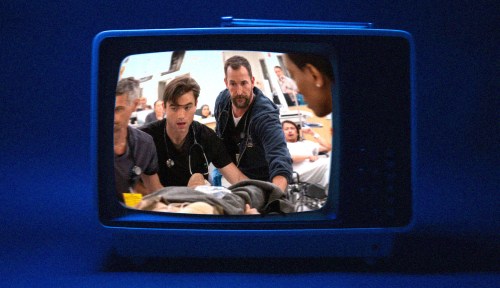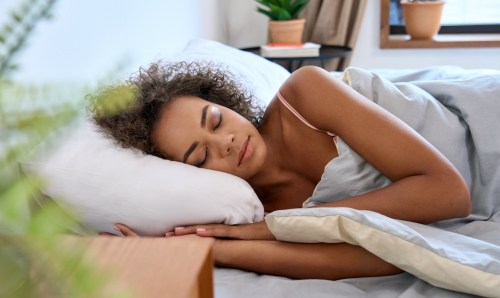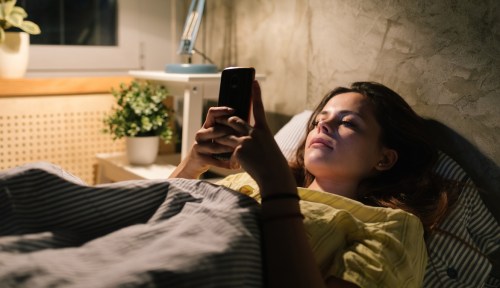Is It a Good Idea to Take Melatonin or a Sleeping Pill on a Plane? Here’s What Sleep Doctors Have to Say
Should you take melatonin, sleeping pills, or OTC sleep aids for flights? Sleep experts share what to know before trying sleep aids.

When it comes to travel, the worst part is often the flight. From the dry air affecting your skin, to the compression socks you bought after reading about airplane inflammation tips, to the loud engine you just can’t seem to escape, to the jet lag… the actual physical part of flying can be super anxiety-inducing. Even if you’re not normally a nervous flier, something about hurtling through the sky and somehow waking up in the future (or past) in a different time zone can be really jarring to the mind and body. While some lucky people can adjust quickly to different time zones, for the rest of us mortals, the fear of jet lag is very real. One way to try to get ahead of any potential jet lag is to use sleeping pills for flights, such as melatonin, prescription sleeping pills, or supplements.
Experts in This Article
neurologist and sleep medicine specialist
board-certified physician, certified sleep specialist, sleep coach, and founder of The Solution is Sleep
board-certified psychiatrist, sleep medicine specialist, and medical reviewer at Rise Science
pharmacist and clinical consultant at BuzzRx
clinical psychologist, sleep specialist, author of The Women’s Guide To Overcoming Insomnia, and Director of Sleep Health at Sleepopolis
“While we all want to have a good sleep on the plane…sometimes the stress and pressure of trying to sleep keeps us from sleeping.” — HaVy Ngo-Hamilton, PharmD, pharmacist and clinical consultant at BuzzRx
“While we all want to have a good sleep on the plane, so we can be refreshed and ready to plunge into all the activities once we get off the plane, sometimes the stress and pressure of trying to sleep keeps us from sleeping,” says pharmacist HaVy Ngo-Hamilton, PharmD, clinical consultant at BuzzRx. It’s normal to want to look into sleeping pills for flights, especially if you’re prone to jet lag or anxious about getting settled once you’ve landed. But how safe is it to use these for a single trip? How much should you take? And is it really a good idea to snag that travel-pack of over-the-counter sleep aid that they sell at the airport? We spoke to the experts to find out. Read on for more information on the most popular sleeping pills for flights, how safe they are, and what the experts actually recommend themselves.
What’s the difference between sleeping pills, OTC sleep aids, and melatonin?
First, it’s important to note that while they all have the potential to make you feel sleepy, sleeping pills (including OTC sleep aids) and melatonin have entirely different mechanisms of action. Sleeping pills, which are available in both over-the-counter and prescription formats, work in a few different ways to support sleep. Many OTC sleep aids utilize specific forms of antihistamines that work like sedatives to make you sleepy. Prescription sleeping pills typically target and activate GABA receptors in the brain for a calming, slow-down effect. Meanwhile, melatonin (a hormone produced by the body in response to darkness) works by cueing the brain that it’s time for sleep. That’s all to say, a sleeping pill can knock you out on contact, while melatonin will more gently “shift your circadian phase, helping you sleep during the nighttime hours of a different time zone,” says Andrew W. Varga, MD, neuroscientist and physician at The Mount Sinai Integrative Sleep Center.
That key difference plays into how and when you can take melatonin versus a sleeping pill on a plane for the best effect, alongside other factors like your sleep goal, and flight time, length, and direction (more on this below).
As a general precaution, however, Dr. Varga does not recommend taking either melatonin or a sleeping pill for the first time on a plane, given that both may occasionally cause adverse effects in some people. (And it’s best not to find out that you’re one of those people while you’re trapped at 30,000 feet.) Among the list of common side effects for melatonin and sleeping pills are excess drowsiness, dizziness, headaches, nausea, and vivid dreams or nightmares.
Being at high altitude on a plane can also put you more at risk for side effects from a sleeping pill or melatonin if you have another medical condition affected by altitude, says Dr. Varga. “For example, sleep apnea can be worsened by sleep medicines due to their muscle-relaxant effects, and dips in oxygen related to apnea can also be worse on a plane due to the altitude, even in a pressurized cabin,” he says. But otherwise, if you’ve previously taken melatonin or a sleeping pill without side effects, you can feel safe taking it on a plane, too.
Popular Sleeping Pills for Flights
If you’ve ever caught yourself walking through the airport pharmacy looking for sleep aids to make your long-haul flight easier, you’ll likely recognize the same few names pop up again and again. But are these safe? We spoke to the experts for their best advice.
Pain Relievers with Sleep Aids
You’ve likely seen brand name pain relievers with a nifty little “PM” at the end to let you know that they’re also good for sleep aids. However, when it comes to just getting sleep on a plane, it might be best to skip these if your only goal is snoozing. “I would not recommend [these] because it is a pain medication and would put stress on the kidneys and may interact with other medications,” says Chester Wu, MD, double-board certified doctor in Psychiatry and Sleep Medicine, and medical reviewer at Rise Science.
You really should only go for these if you actually need the pain relief component, says Dr. Ngo-Hamilton. Instead, for just sleep, Dr. Wu recommends checking with your doctor first. When you’re gearing up for a long trip, scheduling in a pre-departure doctor’s visit might be the last thing you want to add to an already overbooked calendar, but sometimes the right answer is unfortunately, the one that’ll have you doing extra work.
Allergy Medicines or Antihistamines
Another “popular” form of taking sleeping pills for flights is to take allergy meds containing antihistamines or diphenhydramine. However, Dr. Wu also notes that this might not be the best bet and doesn’t recommend this. “It may come with side effects like dizziness, dry mouth, constipation, headaches, and loss of appetite, as well as next-day grogginess that will exacerbate many of the discomforts of sleep loss and jet lag that already come with travel,” Dr. Wu says.
Not to mention, if you plan on booking a rental car once you arrive, taking these meds might not be the best as Dr. Wu adds that “studies show that even one-time use of [diphenhydramine] can lead to next-day sleepiness and impaired psychomotor performance, affecting activities such as driving.” Dr. Wu also adds that the kind of sleep you get with these antihistamines is called “manufactured” sleep, meaning it “isn’t the restorative, ‘naturalistic’ sleep that will help you feel refreshed on arrival.”
There’s also a lot out there about diphenhydramine and its potential link to dementia1, which might make some people wary about taking these meds for sleep. Psychologist and sleep expert Shelby Harris, PsyD, Director of Sleep Health for Sleepopolis, explains that “research is ongoing with nothing conclusive yet,” and that “for occasional use, like for sleeping on a plane, it’s generally considered safe but can leave you feeling groggy after waking up,” So, while yes, technically, a medicine with diphenhydramine could conk you out, it’s probably not in your best interest to go for that.
Dr. Ngo-Hamilton agrees, adding that diphenhydramine should not be used in the elderly (or those over 65) due to increased risk of dementia, or for those consuming alcohol or anxiety medication such as Xanax (alprazolam), as these allergy medicines could exacerbate the sedative properties of alcohol or anxiety medications.
Valerian Root
You might often see supplements with valerian root marketed as things like “might night,” as Dr. Ngo-Hamilton explains, but many are just labeled and marketed as “valerian root.” One thing to keep in mind, Dr. Ngo-Hamilton says, is that the U.S. FDA doesn’t regulate valerian root supplements (or any other supplements), so while “they may have some benefits, their safety and efficacy are not confirmed, [and] they may also interact with other medications.” The best thing to do is discuss with a doctor, as with all supplements.
L-Theanine
While Dr. Wu notes that “L-theanine’s definitive benefit for sleep has not been demonstrated in large scale studies,” he still recommends it as a natural supplement for getting sleep on a plane. “The supplement may help some reduce stress and anxiety and improve their sleep through anxiolysis or anxiety reduction,” he explains. It’s generally well tolerated by most people, and Dr. Wu says he “typically recommends taking 200 mg about an hour before going to bed.”
Magnesium
Dr. Wu recommends patients take “400 to 500 mg of magnesium oxide, 250 to 500 mg of magnesium citrate, or 200 to 400 mg of magnesium glycinate, generally 30 minutes to one hour before bed.” He notes that while some may notice immediate calming, it might also take up to a couple of months of daily supplementation to see an effect. All the more reason to not implement a new sleeping pill the literal day of your flight if you can avoid it.
Chamomile Tea
Another natural recommendation from Dr. Wu and Dr. Harris is good ol’ chamomile tea. “Chamomile tea can be sipped throughout the day or before bed,” Dr. Harris says, making it a good choice for those who might want some help falling asleep and a cozy drink to go with their travels.
For those who may not want to consume something or have anxiety about taking sleeping pills for flights, something chamomile-scented (like a lotion, serum, or essential oil) on your skin might also help you drift off to sleep as well.
Melatonin
Because melatonin works by phase-shifting2 your circadian rhythm (aka signaling to the body that it’s time for sleep even if it isn’t dark out), it only makes sense to take it on a plane in very specific conditions. Namely, “if the flight is happening during a time when you would normally be sleeping in the destination time zone,” says sleep specialist Angela Holliday-Bell, MD. In this way, melatonin can help stave off jet lag by allowing you to transition to the sleep schedule of your target time zone before arriving.
So, flights that happen overnight within the same or similar time zones (long north-south flights) and flights that go east or west through several time zones (where you’d essentially miss a night of sleep without sleeping on the plane) would qualify. The simplest way to remember it is, if you’re on the plane when it’s nighttime (that is, sleeping time) in your target destination, you can take melatonin. But otherwise, you’d be throwing off your circadian rhythm to do so.
For example, take a flight to Tokyo from New York, where you’re leaving mid-morning (when it’s around 1 or 2 a.m. Tokyo time) and arriving in Tokyo the next day, in the middle of the afternoon local time. In that case, it makes circadian sense to sleep on the plane—and take melatonin, if you need, in order to do so—because you’re flying when folks in Tokyo are asleep, and it will be daytime when you arrive. But if you were flying to London from New York during the daytime, leaving in the morning around 8 a.m., you’d be in the air when it’s mid-afternoon in London—which is not a time when you’d typically sleep. If you were to take melatonin and pass out, your circadian rhythm would be off once you arrived: It’d be around 8 p.m., and you’d have just slept through the afternoon, making it tougher to fall asleep that night.
It’s also best to take melatonin a couple hours before what would normally be your bedtime, in order to give it time to kick in. So, in the Tokyo example, if your usual bedtime is midnight, you’d want to take melatonin a couple hours before boarding, so you’d (hopefully) be sleeping right after takeoff (which is near your bedtime, Tokyo time). Whereas, if you were heading to, say, Athens, and you were leaving at noon New York time (aka 7 p.m. Athens time), you would want to wait a couple hours into the flight to take melatonin, so you aren’t sleeping several hours before when you would’ve been going to bed in Athens.
As for the dosage, it’s best to stick to the typical dose you’ve taken previously (and not to go any higher for the flight). A good reference range is between 0.5 and 3 mg, says Dr. Holliday-Bell. (Though many melatonin supplements are available in dosages as high as 5 mg and beyond, taking too much melatonin elevates the risk of side effects and dependency.) Generally, “you don’t need to take more than 1 mg,” Dr. Wu explains, agreeing that most over-the-counter doses are far too large.
Sleeping Pills
To reiterate the above, it’s only a good idea to take sleeping pills on flights if you’ve taken one before with no side effects and you do not have a medical condition affected by altitude. Beyond these qualifications, the same timing rule for taking melatonin on a plane also applies to a sleeping pill—that is, you only want to take it (and be asleep) during a time when you would normally be sleeping in the destination time zone. But with a sleeping pill, you can take it closer to when you’d like to actually fall asleep.
Different from melatonin, most sleeping medications “are metabolized relatively quickly,” says Dr. Varga, “meaning that increased sleep propensity should start within 20 to 30 minutes of taking it.”
That reality can make it tempting to just pop a sleeping pill in order to pass a few hours of a flight snoozing—but again, you’d be better off only taking one at a time when you would typically be asleep in the place where you’re headed, so as not to throw off your circadian rhythm and worsen your jet lag once you arrive.
Because sleeping pills (especially prescription ones) can have a more potent drowsiness-inducing effect than melatonin, it’s also wise to only take one on a plane if you have at least seven hours remaining of the flight. That said, if you needed to be awoken during that time window after taking a sleeping pill, it would be doable (most sleeping pills are not so potent as to make someone “completely un-arousable,” says Dr. Varga), but you’d certainly feel groggy and foggy. And that could interfere with your functioning, as well as make it unsafe to do things like operate a vehicle, says Dr. Holliday-Bell.
Tips To Get Restful Sleep on a Plane, Besides Taking Sleeping Pills for Flights
While taking sleeping pills for flights might help you fall asleep on a plane, so too, can other behavior changes. With the help of our experts, we break down some other tips for getting more restful sleep on a flight:
Calculate if you can actually skip the melatonin
“If you’re crossing fewer than five time zones, you may not need melatonin at all, and instead can align with your destination time zone by getting light and avoiding light, eating, and being active at the right times ([based] on your destination’s times.” Dr. Wu says. By essentially pretending you’re already living in the future, wherever your destination is, you might be able to overcome jet lag more quickly, he explains.
Pack accessories
Permission to go hog wild in that one travel section of TJ Maxx, granted. Well, kind of. Dr. Wu also recommends using earplugs, an eye mask, and a neck pillow in order to sleep better on a plane. Prioritize your comfort so you can snooze better and get some actually restful sleep, and your body will thank you.
Dress in layers
Traveling will have you sweating buckets in the security line, only to be freezing in your actual seat a few hours later. Control your temperature by dressing in layers, as Dr. Wu recommends, as this can also help you sleep better on a plane. There’s nothing worse than waking up from the middle of a nap just because you’re too hot or too cold.
Fuel your body intentionally and avoid alcohol
As tempting as the TGI Fridays in the terminal can be, skipping large meals, caffeine, and alcohol pre-flight may be able to help you sleep better on the plane, Dr. Wu says. “You may think alcohol may help with your sleep, but the truth is alcohol reduces sleep quality,” Dr. Ngo-Hamilton adds.
Staying hydrated will also help you get more restful sleep on a plane, Dr. Harris adds, so feel free to splurge on that $7 bottle of water at the airport if you think it’ll help you stay hydrated in the long run.
Pick your seat wisely
While sleeping in a first-class lay down seat is always going to make for nicer sleep, there are some things you can do to ensure better sleep no matter what section of the plane your seat is in. As Dr. Harris suggests, picking a seat that’s ideally away from a bathroom or heavy foot traffic might help you be able to drift off to sleep (and stay that way) easier. If you’re also able to plan ahead, picking a seat with legroom might also help you stretch out and relax, too.
Try old-fashioned relaxation techniques
There’s nothing wrong with trying old-fashioned techniques like reading or breathwork to fall asleep and relax on a plane, Dr. Harris notes. These techniques can be great to help you calm down, whether you’ve got turbulence anxiety, or just need help relaxing and drifting off to sleep. Try downloading a free meditation app and taking it for a test run while you’re waiting for your flight to board, or pick up a fun paperback at the airport to take your mind off any sleep-related stress.
- ↩︎Fabiano, Nicholas et al. “Chronic high-dose dimenhydrinate use contributing to early multifactorial cognitive impairment.” BMJ case reports vol. 17,3 e258493. 7 Mar. 2024, doi:10.1136/bcr-2023-258493
Sharkey, Katherine M, and Charmane I Eastman. “Melatonin phase shifts human circadian rhythms in a placebo-controlled simulated night-work study.” American journal of physiology. Regulatory, integrative and comparative physiology vol. 282,2 (2002): R454-63. doi:10.1152/ajpregu.00135.2001
↩︎
Sign Up for Our Daily Newsletter
Get all the latest in wellness, trends, food, fitness, beauty, and more delivered right to your inbox.
Got it, you've been added to our email list.










